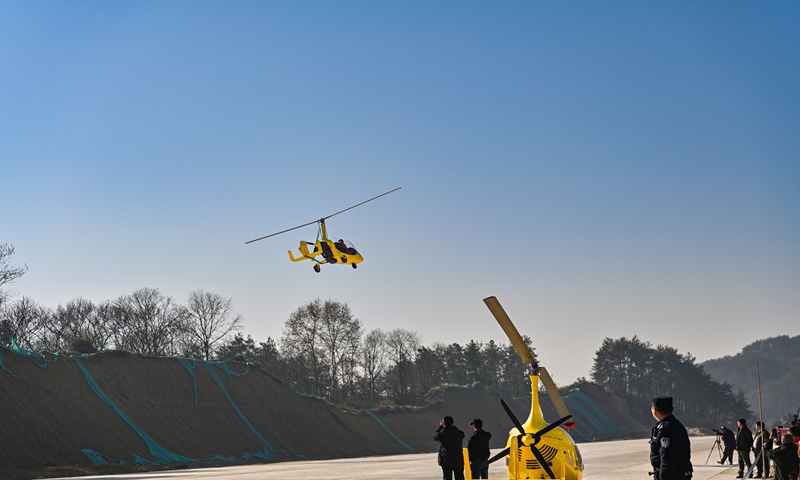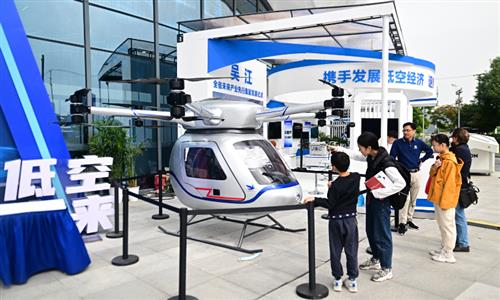Low-altitude economy to shatter the sky, injecting strong momentum into 2025 growth
Sector poised to drive robust, sustained growth momentum in 2025: experts

Tourists and local residents in Yuexi county, Anqing in East China's Anhui Province enjoy an experience event for operating low-flying aircrafts on January 1, 2025 to celebrate the New Year. Photo: VCG
Editor's Note: The tone-setting Central Economic Work Conference held at the end of 2024 outlined nine key economic tasks for 2025. The meeting efforts should be made to drive the development of new quality productive forces through scientific and technological innovation and build a modernized industrial system. What efforts are being made? What new trends are emerging? The Global Times is publishing a series of articles focusing on the development of new quality productive forces in 2025. This is the first installment.The two-day EVTOL China 2025 summit kicked off on Tuesday in Shanghai. The summit brought together over 200 industry experts and stakeholders to discuss key developments in the electric vertical take-off and landing (eVTOL) industry, including the evolution of urban air mobility ecosystems, advanced aircraft manufacturing technologies and new commercial operating models.
EVTOL is seen as a major enabler of the low-altitude economy.
As a key representative of the new quality productive forces in China, the low-altitude economy was included in the government work report for the first time in 2024, marking its emergence as a trillion-yuan market.
After a year of rapid expansion, several major milestones were achieved by the end of 2024, including the creation of a low-altitude economy development department by China's top economic planner, the National Development and Reform Commission (NDRC), state-owned enterprises investing capital in low-altitude economy companies, and the establishment of related programs at many universities.
Looking to 2025, industry leaders and experts told the Global Times that with increasing supportive policies, the low-altitude economy is poised to overcome barriers and achieve unprecedented growth, fueling even faster and more vigorous growth. This will also drive the expansion of numerous related industries, providing robust and sustained momentum for the economy.
'New blue ocean'
"As a completely new factor of production, the low-altitude economy is set to create a new blue ocean, unlocking fresh opportunities for economic growth," Xie Jia, senior vice-president of Shanghai-based eVTOL developer AutoFlight, told the Global Times on Tuesday.
The low-altitude airspace below 1,000 meters is almost an untapped resource, and it is also environmentally friendly. New economic activities generated within this space will not lead to any crowding out of existing ones on the grounds but will instead drive brand-new growth. This is why it is seen as a key representative of new quality productive forces, Xie said.
The agenda-setting Central Economic Work Conference held in December 2024 highlighted that efforts should be made to drive the development of new quality productive forces through scientific and technological innovation and build a modernized industrial system.
It is necessary to strengthen basic research and strive for breakthroughs in key and core technologies, adopt forward-thinking arrangements for major technological projects, conduct large-scale demonstrations for the application of new technologies, products, and scenarios, launch an AI Plus initiative, nurture industries of the future, and boost China's strategic scientific and technological strength, the meeting noted.
Clear roadmap
The low-altitude economy is set to enter a new chapter in 2025. With more coordinated and orderly development under the guidance of the NDRC, a clear roadmap is gradually taking shape, Luo Jun, executive director of the China Low Altitude Economic Alliance, told the Global Times on Tuesday.
It will gradually establish unified standards, reducing inefficiencies and fostering more streamlined growth, Luo noted.
From hardware like aircraft manufacturing to software such as air traffic control systems and operational management, as well as a wide range of applications in logistics, express delivery, emergency response, disaster relief, urban management, and power line inspections, the low-altitude economy is poised for significant expansion by driving the development of an entire ecosystem, Luo said.
The market size of China's low-altitude economy is projected to reach 1.5 trillion yuan ($205 billion) by 2025, and could expand to 3.5 trillion yuan by 2035, according to data from the Civil Aviation Administration of China.
As of 2023, the number of registered civilian drones in China surpassed 1 million for the first time, reaching 1.267 million, cementing its position as the global leader. The country is also home to 19,000 drone companies, including leading firms like DJI and XPENG AEROHT, according to media reports.
At the 15th China International Aviation and Aerospace Exhibition held in Zhuhai, South China's Guangdong Province in November 2024, XPENG AEROHT unveiled the first public demonstration flight of its modular flying car, the "Land Aircraft Carrier."
It remains the world's only car capable of storing an "aircraft" in its trunk. The manufacturing base for the flying car is currently under construction, with deliveries expected to begin in 2026, the company said in a statement sent to the Global Times on Tuesday.
"Millions of drones have already changed the way we live and work. In the future, drones will evolve into flying robots, driven not only by advanced hardware but also by AI serving as their brain," Luo said, adding that the low-altitude economy represents the convergence of numerous advanced technologies and exemplifies a new business model that will continue fueling economic growth.



